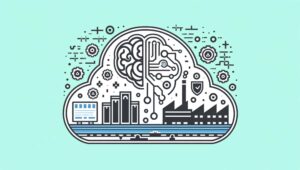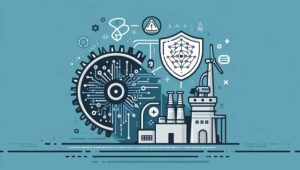Artificial intelligence (AI) has been transforming various aspects of our lives, and deep learning is at the forefront of this revolution. Deep learning, a subset of machine learning that uses multi-layered neural networks to simulate complex decision-making processes, is capable of ingesting and processing unstructured data, like text and images, and automating feature extraction [1]. It enables computers to learn by example, making it an important element of data science, including statistics and predictive modeling [2].
Deep learning attempts to replicate the activity in layers of neurons in the neocortex, aiming to create a network of connections in machines similar to the human brain, which has about 100 billion neurons, each connecting to about 100,000 of its neighbors [3]. This powerful technique has revolutionized various industries, including image recognition, medical diagnostics, and autonomous vehicles, but it also faces several challenges and future prospects [1] [4] [5]. In this article, we will dive into the world of AI deep learning, exploring its key concepts, applications, techniques, and future prospects.
Understanding Deep Learning
Deep learning, a subset of machine learning and artificial intelligence (AI), uses artificial neural networks inspired by the human brain to model and solve complex problems by learning from large amounts of data [4]. These models consist of multiple layers of interconnected nodes, with the input layer ingesting data for processing and the output layer making the final prediction or classification [2]. Through processes like forward propagation and backpropagation, deep learning algorithms adjust and fit themselves for accuracy, using techniques such as gradient descent to calculate errors in predictions and optimize the weights and biases of the function [1] [2].
Deep learning enables computers to learn by example, similar to how a toddler learns to identify a dog [2]. It can process unstructured data, like text and images, and automate feature extraction, reducing dependency on human experts [1] [2]. Deep learning models are trained using a large set of labeled data and neural network architectures, requiring both substantial amounts of data and computing power [2] [4] [5].
Some key points about deep learning:
- It is used to perform classification tasks and recognize patterns in photos, text, audio, and other various data [2] [4] [5]
- It automates tasks that would normally need human intelligence, such as describing images or transcribing audio files [4] [5]
- It is an important element of data science, including statistics and predictive modeling [2] [4] [5]
- Each successive layer in an artificial neural network learns to transform its input data into a more abstract and composite representation [3]
Applications of Deep Learning Today
Deep learning drives many applications and services that improve automation, performing analytical and physical tasks without human intervention [1]. It is used in various industries, including law enforcement, financial services, customer service, and healthcare [1]. Deep learning models can analyze large volumes of data, learning intricate structures and patterns, making them powerful for AI development [10]. They process information in ways similar to the human brain, making them applicable to many tasks people do [2].
Some popular use-cases of deep learning include:
- Image and video recognition: Deep learning models are used for image classification, object detection, localization, and computer vision, providing extreme accuracy [10] [12] [2].
- Natural language processing: Deep learning has revolutionized NLP, enabling better text analysis, understanding, classification, sentiment analysis, and language translation [10] [12].
- Voice recognition and generation: Deep learning powers virtual assistants like Siri, Google Assistant, and Amazon Alexa, enabling them to understand natural language and respond accordingly [10] [11] [12].
- Healthcare: Deep learning is used for predictive models in disease diagnosis, prognosis, treatment recommendations, and medical image analysis [11] [13] [14].
- Autonomous vehicles: Deep learning plays a crucial role in the advancement of self-driving cars, allowing for safer and more effective transportation through object detection, tracking, and complex decision-making [11] [13] [14].
Other applications include fraud detection [11] [13], personalized recommendations in e-commerce and content streaming platforms [11] [12] [14], game development and character animation [13], climate change analysis [14], and real-time translation services [14]. Deep learning systems can derive insights that they might not have been trained on by analyzing large amounts of structured and unstructured data and uncovering complex patterns in images, text, and audio [2].
Deep learning’s high recognition accuracy is crucial for potential applications where safety is a major factor, such as in autonomous cars or medical devices [4] [5]. If an organization can accommodate the necessary data and computing power, deep learning can be used in areas such as digital assistants, fraud detection, facial recognition, and biometrics [4] [5] [12].
Key Techniques in Deep Learning
Deep learning algorithms encompass a wide range of techniques, each with its unique strengths and applications. Convolutional Neural Networks (CNNs) are primarily used for image processing and object detection, while Long Short Term Memory Networks (LSTMs) can learn and memorize long-term dependencies, making them useful in time-series prediction [16]. Recurrent Neural Networks (RNNs) have connections that form directed cycles, allowing the outputs from the LSTM to be fed as inputs to the current phase [16]. Generative Adversarial Networks (GANs) are generative deep learning algorithms that create new data instances resembling the training data [16].
Other notable techniques include:
- Radial Basis Function Networks (RBFNs): Perform classification by measuring the input’s similarity to examples from the training set [16].
- Multilayer Perceptrons (MLPs): Feedforward neural networks with multiple layers of perceptrons that have activation functions [16].
- Self Organizing Maps (SOMs): Enable data visualization to reduce the dimensions of data through self-organizing artificial neural networks [16].
- Deep Belief Networks (DBNs): Generative models that consist of multiple layers of stochastic, latent variables [16].
- Restricted Boltzmann Machines (RBMs): Stochastic neural networks that can learn from a probability distribution over a set of inputs [16].
- Autoencoders: A specific type of feedforward neural network in which the input and output are identical [16].
The most widely used deep learning techniques are [6]:
| Technique | Description |
|---|---|
| Classic Neural Networks | Also known as Fully Connected Neural Networks, consist of multiple layers of nodes where each node in a layer is connected to every node in the next layer [17]. |
| Convolutional Neural Networks (CNNs) | Advanced types of neural networks designed to handle higher complexity, preprocessing, and data compilation [17]. |
| Recurrent Neural Networks (RNNs) | Used for predicting sequences, with memory to predict the next data point in a sequence [17]. |
| Generative Adversarial Networks (GANs) | Consist of two parts, a generator and a discriminator, with the generator creating new data instances and the discriminator evaluating them for authenticity [17]. |
| Self-Organizing Maps (SOMs) | Used for data visualization, reducing dimensions of data with self-organizing neural networks [17]. |
| Restricted Boltzmann Machines (RBMs) | Stochastic network models where nodes are connected in a circular arrangement, producing model parameters [17]. |
| Deep Reinforcement Learning | Used for decision making in situations with uncertainty, using the concept of reward and punishment to make decisions [17]. |
| Autoencoders | Used for unsupervised learning of efficient codings, learning a representation (encoding) for a set of data [17]. |
Backpropagation and Gradient Descent are two essential techniques used in training deep learning models. Backpropagation is a method used to train neural networks, adjusting the weights of the connections between nodes based on the error of the output [17]. Gradient Descent is an optimization algorithm used to minimize some function by iteratively moving in the direction of steepest descent as defined by the negative of the gradient [17]. Deep learning systems can perform feature extraction automatically, meaning they don’t require supervision to add new features [2]. They can analyze large amounts of data and uncover complex patterns in images, text, and audio, deriving insights that they might not have been trained on [2].
Challenges and Future of Deep Learning
Deep learning faces several challenges that need to be addressed for its continued growth and widespread adoption. One of the primary challenges is the requirement for significant computing power, as deep learning models rely on high-performance graphical processing units (GPUs) to handle large volumes of calculations [1]. Additionally, deep learning models require vast amounts of labeled data for training, which can be a limitation in some applications.
Responsible and equitable AI development is crucial to address issues like data privacy and potential misuse of AI technologies. Overfitting is another challenge in deep learning, where the data analysis focuses too closely on the dataset, recording mundane and non-important parameters, leading to skewed results. Data privacy is also a concern, as deep learning requires large-scale data recording to achieve accuracy in results, which can conflict with privacy laws and restrictions.
To further advance the field of deep learning, several areas require further investigation and research:
- A broader investigation of various deep learning techniques, focusing on deep unsupervised and deep reinforcement learning techniques.
- Comprehensive studies on main methodologies in deep learning, such as transfer learning, federated learning, and online learning.
- Exploring the potential of multilingual sentiment analysis and developing models that understand diverse languages and their unique linguistic characteristics.
- Addressing ethical considerations to mitigate biases and ensure continuous adaptability.
Deep learning is vulnerable to producing inaccurate results if there is a slight change in the input data, making it unstable and unreliable for mission-critical or decision-making applications. Overcoming these challenges and focusing on the future research areas will be crucial for the continued growth and success of deep learning in various domains.
Getting Started with Deep Learning
To embark on your deep learning journey, enroll in the Deep Learning Specialization course, which covers essential topics like neural networks, convolutional neural networks, and sequence models [7] [19]. Coursera also offers a range of AI courses and specializations, such as Machine Learning, Generative AI with LLMs, Open Source Models with Hugging Face, Mathematics for Machine Learning and Data Science, AI for Everyone, and Prompt Engineering with Llama 2 [7]. Stay updated on the latest AI news, events, and courses by subscribing to the largest weekly AI newsletter [7]. Free resources like “How to Build Your Career in AI,” “Machine Learning Yearning,” and “A Complete Guide to Natural Language Processing” are also available to expand your knowledge [7].
Before diving into AI, master prerequisite skills such as basic mathematics, statistics, and programming languages like Python or R [8] [18]. Specialized AI skills include:
- Statistics and mathematics (linear algebra, probability, calculus, numerical optimization) [8] [18]
- Programming (high-level languages like Python or Java, low-level languages like C or C++) [8] [18]
- Data structures and manipulation [8]
- Data science [8]
- Machine learning [8]
- Deep learning [8]
Python and R are the most popular languages in the AI community due to their simplicity, flexibility, and availability of data science libraries [8]. Top Python AI tools and packages include:
- pandas
- NumPy
- Scikit-Learn
- PyTorch
- Keras
- TensorFlow
- OpenAI API
- Cohere API
- Anthropic API [8]
To reinforce your understanding, implement what you learn, starting with basic blocks like logistic regression, SVMs, kNN, PCA, and GMMs in Python, and gradually progress to more complex algorithms like backpropagation from scratch [18]. Read and understand research papers and journals on deep learning, participate in Kaggle competitions, and work on your own ideas and projects to build confidence and learn from others [18].
Major cloud providers offer various services for deep learning:
- IBM watsonx: A portfolio of business-ready tools, applications, and solutions designed to reduce the costs and hurdles of AI adoption while optimizing outcomes and responsible use of AI [1].
- AWS: Offers services like Amazon SageMaker (fully managed service for building, training, and deploying machine learning models), Amazon Elastic Inference (attaching low-cost GPU-powered instances to existing Amazon EC2 instances), Amazon Forecast (generating accurate forecasts using machine learning), and Amazon Fraud Detector (fully managed service for detecting online fraud) [4] [5].
Learning AI can lead to job opportunities with a median salary of $136,620 per year [9]. Curiosity and adaptability are essential due to the rapidly evolving nature of AI [9]. Create a learning plan, master the prerequisite skills, start learning AI skills, and get familiar with AI tools and programs to succeed in this field [9].
Conclusion
Artificial intelligence and deep learning are revolutionizing various industries, from image recognition and natural language processing to healthcare and autonomous vehicles. As we have explored in this article, deep learning techniques such as CNNs, RNNs, and GANs are driving these advancements, enabling machines to learn from vast amounts of data and perform complex tasks with remarkable accuracy. However, challenges like computing power requirements, data privacy concerns, and the need for responsible AI development must be addressed to ensure the continued growth and widespread adoption of deep learning.
The future of deep learning is promising, with ongoing research in areas like unsupervised and reinforcement learning, transfer learning, and multilingual sentiment analysis. As you embark on your own deep learning journey, remember to master the prerequisite skills, stay curious, and continuously adapt to this rapidly evolving field. With dedication and the right resources, you can contribute to the exciting advancements in AI and deep learning, shaping the future of technology and its impact on our lives.
FAQs
What is the basic concept of AI and deep learning?
Deep learning is a subset of artificial intelligence (AI) that enables computers to emulate the human brain’s data-processing methods. These deep learning systems are capable of identifying intricate patterns across diverse forms of data, such as images, text, and sounds, allowing them to deliver precise insights and forecasts.
Can you describe AI in simple terms?
Artificial Intelligence (AI) is a field within computer science that equips computers with capabilities akin to human intelligence. Essentially, it’s about programming computers to learn from information, make decisions, and interact in human-like ways, thereby enabling machines to perform tasks intelligently and autonomously.
What is a beginner’s explanation of AI?
For those new to the concept, AI involves sophisticated technology designed to enhance the efficiency of tasks typically performed by humans. It has the ability to learn from data, solve complex problems, make informed decisions, and engage in interactions with humans with a high degree of precision.
How would you define deep learning for a non-expert?
Deep learning is a specialized form of machine learning and AI that replicates how humans acquire certain knowledge. By training deep learning models, they can carry out classification tasks and detect patterns in a variety of data, including images, text, and audio, much like the human brain does.
References
[1] – https://www.ibm.com/topics/deep-learning
[2] – https://www.techtarget.com/searchenterpriseai/definition/deep-learning-deep-neural-network
[3] – https://towardsdatascience.com/simply-deep-learning-an-effortless-introduction-45591a1c4abb
[4] – https://aws.amazon.com/what-is/deep-learning/
[5] – https://link.springer.com/article/10.1007/s42979-021-00815-1
[6] – https://www.linkedin.com/pulse/what-deep-learning-definition-techniques-examples-neil-sahota-%E8%90%A8%E5%86%A0%E5%86%9B-
[7] – https://www.deeplearning.ai/
[8] – https://www.datacamp.com/blog/how-to-learn-ai
[9] – https://www.coursera.org/articles/how-to-learn-artificial-intelligence
[10] – https://www.datacamp.com/blog/how-to-learn-deep-learning
[11] – https://www.knowledgehut.com/blog/data-science/deep-learning-applications
[12] – https://www.analyticsvidhya.com/blog/2023/06/common-applications-of-deep-learning-in-artificial-intelligence/
[13] – https://www.analyticsinsight.net/advancements-and-applications-of-deep-learning-2023-edition/
[14] – https://skilloutlook.com/education/top-10-deep-learning-applications-in-2023
[15] – https://www.meltwater.com/en/blog/fundamentals-of-deep-learning
[16] – https://www.simplilearn.com/tutorials/deep-learning-tutorial/deep-learning-algorithm
[17] – https://www.upgrad.com/blog/top-deep-learning-techniques-you-should-know-about/
[18] – https://www.quora.com/Whats-the-most-effective-way-to-get-started-with-deep-learning
[19] – https://towardsdatascience.com/how-to-get-started-with-deep-learning-1f4e9f9b221e
[20] – https://blogs.nvidia.com/blog/whats-difference-artificial-intelligence-machine-learning-deep-learning-ai/



